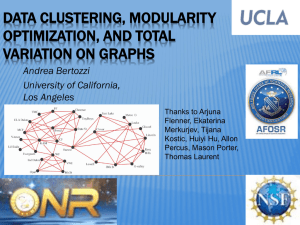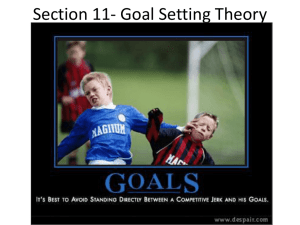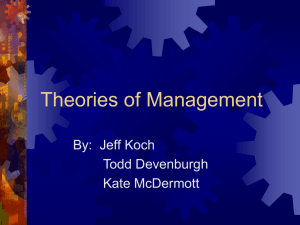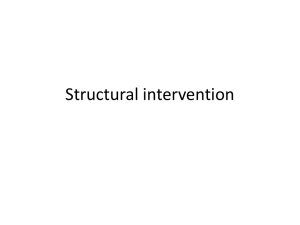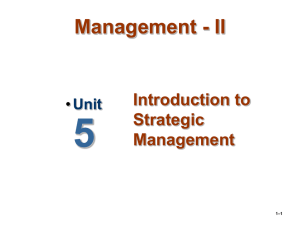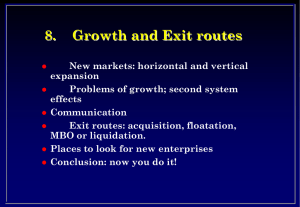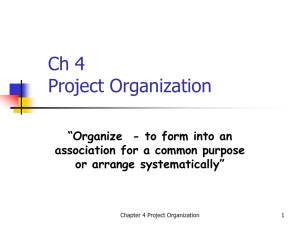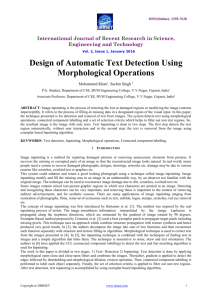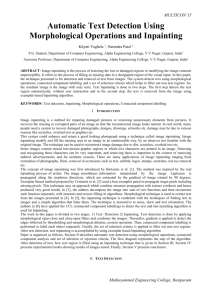Slides
advertisement
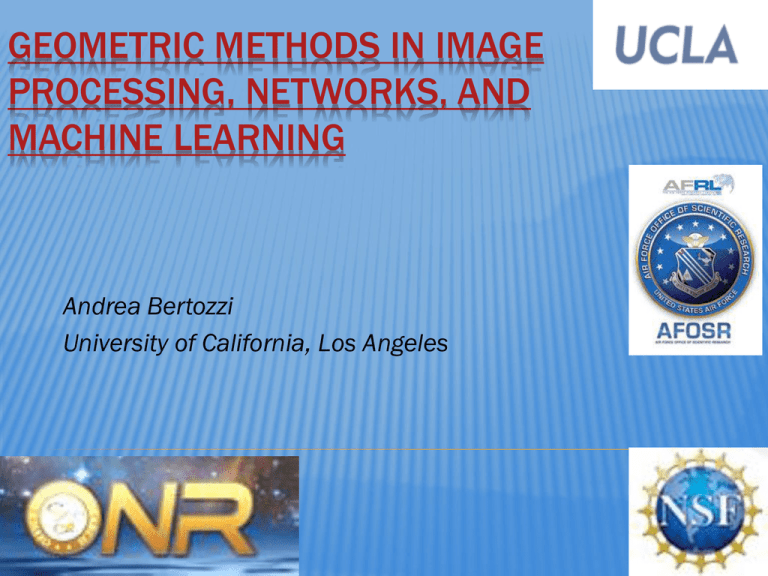
GEOMETRIC METHODS IN IMAGE PROCESSING, NETWORKS, AND MACHINE LEARNING Andrea Bertozzi University of California, Los Angeles DIFFUSE INTERFACE METHODS Total variation Ginzburg-Landau functional W is a double well potential with two minima Total variation measures length of boundary between two constant regions. GL energy is a diffuse interface approximation of TV for binary functionals DIFFUSE INTERFACE EQUATIONS AND THEIR SHARP INTERFACE LIMIT Allen-Cahn equation – L2 gradient flow of GL functional Approximates motion by mean curvaure - useful for image segmentation and image deblurring. Cahn-Hilliard equation – H-1 gradient flow of GL functional Approximates Mullins-Sekerka problem (nonlocal): Pego; Alikakos, Bates, and Chen. Conserves the mean of u. Used in image inpainting – fourth order allows for two boundary conditions to be satisfied for inpainting. MY FIRST INTRODUCTION TO WAVELETS Impromptu tutorial by Ingrid Daubechies over lunch in the cafeteria at Bell Labs Murray Hill c. 1987-8 when I was a PhD student in their GRPW program. summertime Fall, winter and spring ROUGHLY 20 YEARS LATER….. Then PhD student Julia Dobrosotskaya asked me if she could work with me on a thesis that combines wavelets and “UCLA” style algorithms. Result was the wavelet Ginzburg-Laundau functional to connect L1 compresive sensing with L2-based wavelet constructions. IEEE Trans Image Proc. 2008, Interfaces and Free Boundaries 2011, SIAM J. Image Proc. 2013. This work was the initial inspiration for our new work on nonlocal graph based methods. inpainting Bar code deconvolution WEIGHTED GRAPHS FOR “BIG DATA” In a typical application we have data supported on the graph, possibly high dimensional. The above weights represent comparison of the data. Examples include: voting records of US Congress – each person has a vote vector associated with them. Nonlocal means image processing – each pixel has a pixel neighborhood that can be compared with nearby and far away pixels. GRAPH CUTS AND TOTAL VARIATION Mimal cut Maximum cut Total Variation of function f defined on nodes of a weighted graph: Min cut problems can be reformulated as a total variation minimization problem for binary/multivalued functions defined on the nodes of the graph. DIFFUSE INTERFACE METHODS ON GRAPHS Bertozzi and Flenner MMS 2012. CONVERGENCE OF GRAPH GL FUNCTIONAL van Gennip and ALB Adv. Diff. Eq. 2012 AN MBO SCHEME ON GRAPHS FOR SEGMENTATION AND IMAGE PROCESSING E. Merkurjev, T. Kostic and A.L. Bertozzi, to appear SIAM J Imaging Sci 2013. Instead of minimizating the GL functional Apply MBO scheme involving a simple algorithm alternating the heat equation with thresholding. MBO stands for Merriman Bence and Osher who invented this scheme for differential operators a couple of decades ago….. TWO-STEP MINIMIZATION PROCEDURE BASED ON CLASSICAL MBO SCHEME FOR MOTION BY MEAN CURVATURE (NOW ON GRAPHS) 1) propagation by graph heat equation + forcing term 2) thresholding Simple! And often converges in just a few iterations (e.g. 4 for MNIST dataset) ALGORITHM • • • • • I) Create a graph from the data, choose a weight function and then create the symmetric graph Laplacian. II) Calculate the eigenvectors and eigenvalues of the symmetric graph Laplacian. It is only necessary to calculate a portion of the eigenvectors*. III) Initialize u. IV) Iterate the two-step scheme described above until a stopping criterion is satisfied. *Fast linear algebra routines are necessary – either Raleigh-Chebyshev procedure or Nystrom extension. TWO MOONS SEGMENTATION Second eigenvector segmentation Our method’s segmentation IMAGE SEGEMENTATION Original image 1 Handlabeled grass region Original image 2 Grass label transferred IMAGE SEGMENTATION Handlabeled cow region Handlabeled sky region Cow label transferred Sky label transferred BERTOZZI-FLENNER VS MBO ON GRAPHS Graph MBO BF BF Graph MBO EXAMPLES ON IMAGE INPAINTING Original image Nonlocal TV inpainting Damaged image Local TV inpainting Our method’s result SPARSE RECONSTRUCTION Original image Damaged image Nonlocal TV inpainting Local TV inpainting Our method’s result PERFORMANCE NLTV VS MBO ON GRAPHS CONVERGENCE AND ENERGY LANDSCAPE FOR CHEEGER CUT CLUSTERING Bresson, Laurent, Uminsky, von Brecht (current and former postdocs of our group), NIPS 2012 Relaxed continuous Cheeger cut problem (unsupervised) Ratio of TV term to balance term. Prove convergence of two algorithms based on CS ideas Provides a rigorous connection between graph TV and cut problems. GENERALIZATION MULTICLASS MACHINE LEARNING PROBLEMS (MBO) Garcia, Merkurjev, Bertozzi, Percus, Flenner, 2013 Semi-supervised learning Instead of double well we have N-class well with Minima on a simplex in N-dimensions MULTICLASS EXAMPLES – SEMI-SUPERVISED Three moons MBO Scheme 98.5% correct. 5% ground truth used for fidelity. Greyscale image 4% random points for fidelity, perfect classification. MNIST DATABASE Comparisons Semi-supervised learning Vs Supervised learning We do semi-supervised with only 3.6% of the digits as the Known data. Supervised uses 60000 digits for training and tests on 10000 digits. TIMING COMPARISONS PERFORMANCE ON COIL WEBKB COMMUNITY DETECTION – MODULARITY OPTIMIZATION Joint work with Huiyi Hu, Thomas Laurent, and Mason Porter Newman, Girvan, Phys. Rev. E 2004. [wij] is graph adjacency matrix P is probability nullmodel (Newman-Girvan) Pij=kikj/2m ki = sumj wij (strength of the node) Gamma is the resolution parameter gi is group assignment 2m is total volume of the graph = sumi ki = sumij wij This is an optimization (max) problem. Combinatorially complex – optimize over all possible group assignments. Very expensive computationally. BIPARTITION OF A GRAPH Given a subset A of nodes on the graph define Vol(A) = sum i in A ki Then maximizing Q is equivalent to minimizing Given a binary function on the graph f taking values +1, -1 define A to be the set where f=1, we can define: EQUIVALENCE TO L1 COMPRESSIVE SENSING Thus modularity optimization restricted to two groups is equivalent to This generalizes to n class optimization quite naturally Because the TV minimization problem involves functions with values on the simplex we can directly use the MBO scheme to solve this problem. MODULARITY OPTIMIZATION MOONS AND CLOUDS LFR BENCHMARK – SYNTHETIC BENCHMARK GRAPHS Lancichinetti, Fortunato, and Radicchi Phys Rev. E 78(4) 2008. Each mode is assigned a degree from a powerlaw distribution with power x. Maximum degree is kmax and mean degree by <k>. Community sizes follow a powerlaw distribution with power beta subject to a constraint that the sum of of the community sizes equals the number of nodes N. Each node shares a fraction 1-m of edges with nodes in its own community and a fraction m with nodes in other communities (mixing parameter). Min and max community sizes are also specified. NORMALIZED MUTUAL INFORMATION Similarity measure for comparing two partitions based on information entropy. NMI = 1 when two partitions are identical and is expected to be zero when they are independent. For an N-node network with two partitions LFR1K(1000,20,50,2,1,MU,10,50) LFR1K(1000,20,50,2,1,MU,10,50) LFR50K Similar scaling to LFR1K 50,000 nodes Approximately 2000 communities Run times for LFR1K and 50K MNIST 4-9 DIGIT SEGMENTATION 13782 handwritten digits. Graph created based on similarity score between each digit. Weighted graph with 194816 connections. Modularity MBO performs comparably to Genlouvain but in about a tenth the run time. Advantage of MBO based scheme will be for very large datasets with moderate numbers of clusters. 4-9 MNIST SEGMENTATION CONCLUSIONS AND FUTURE WORK (new preprint) Yves van Gennip, Nestor Guillen, Braxton Osting, and Andrea L. Bertozzi, Mean curvature, threshold dynamics, and phase field theory on finite graphs, 2013. Diffuse interface formulation provides competitive algorithms for machine learning applications including nonlocal means imaging Extends PDE-based methods to a graphical framework Future work includes community detection algorithms (very computationally expensive) Speedup includes fast spectral methods and the use of a small subset of eigenfunctions rather than the complete basis Competitive or faster than split-Bregman methods and other L1-TV based methods CLUSTER GROUP AT ICERM SPRING 2014 People working on the boundary between compressive sensing methods and graph/machine learning problems February 2014 (month long working group) Workshop to be organized Looking for more core participants
